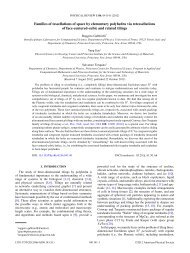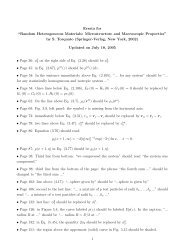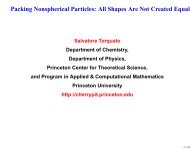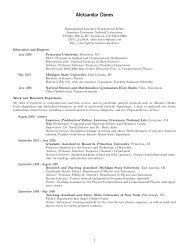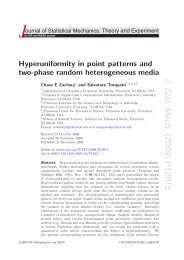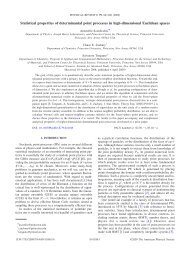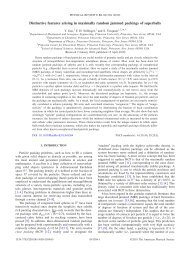Hydration and percolation at the setting point - Complex Materials ...
Hydration and percolation at the setting point - Complex Materials ...
Hydration and percolation at the setting point - Complex Materials ...
You also want an ePaper? Increase the reach of your titles
YUMPU automatically turns print PDFs into web optimized ePapers that Google loves.
particles into contact. In contrast, real cement pastes contain large<br />
clusters of particles th<strong>at</strong> are initially touching [46,47], so <strong>the</strong>y can be<br />
bonded by <strong>the</strong> form<strong>at</strong>ion of a small amount of hydr<strong>at</strong>ion product.<br />
This idea has been tested in a study in which <strong>the</strong> initial extent of agglomer<strong>at</strong>ion<br />
of <strong>the</strong> particles was system<strong>at</strong>ically varied [49]; as<br />
expected, realistic predictions of DOH can be obtained with reasonable<br />
degrees of agglomer<strong>at</strong>ion. Several o<strong>the</strong>r simul<strong>at</strong>ion studies<br />
have predicted r<strong>at</strong>her low DOH <strong>at</strong> <strong>the</strong> <strong>percol<strong>at</strong>ion</strong> threshold (e.g.,<br />
[2,27]), but <strong>the</strong>y did not optimize <strong>the</strong> particle spacing <strong>at</strong> <strong>the</strong> start of<br />
<strong>the</strong> process. Evidently, <strong>the</strong> methods used for r<strong>and</strong>om placement of<br />
particles into <strong>the</strong> box in those studies resulted in many of <strong>the</strong> particles<br />
being in very close proximity. Unfortun<strong>at</strong>ely, it is difficult to<br />
quantify <strong>the</strong> initial st<strong>at</strong>e of agglomer<strong>at</strong>ion of a paste, <strong>and</strong> without<br />
th<strong>at</strong> inform<strong>at</strong>ion one cannot predict <strong>the</strong> DOH <strong>at</strong> <strong>the</strong> <strong>percol<strong>at</strong>ion</strong><br />
threshold.<br />
The critical exponent for <strong>the</strong> elastic modulus of a percol<strong>at</strong>ing HCSS<br />
system is expected to be much higher than wh<strong>at</strong> we observe [11,13].<br />
The physical origin of <strong>the</strong> high exponent is <strong>the</strong> very broad range of<br />
stiffness of <strong>the</strong> linkages cre<strong>at</strong>ed by overlapping particles: deep interpenetr<strong>at</strong>ion<br />
of particles cre<strong>at</strong>es very stiff links, while tangency cre<strong>at</strong>es<br />
flexible ones. The thinner <strong>the</strong> soft shell, <strong>the</strong> smaller <strong>the</strong> range of vari<strong>at</strong>ion<br />
in stiffness will be, since overlapping is limited to <strong>the</strong> depth of<br />
<strong>the</strong> shell. Moreover, <strong>the</strong> aggreg<strong>at</strong>ion of particles th<strong>at</strong> occurs in a paste<br />
enhances <strong>the</strong> number of strong links, since <strong>the</strong> hydr<strong>at</strong>ion products are<br />
depositing on particles already in contact, <strong>and</strong> th<strong>at</strong> must alter <strong>the</strong> distribution<br />
of stiffnesses anticip<strong>at</strong>ed by <strong>the</strong> <strong>the</strong>ory. These factors contribute<br />
to a reduction in <strong>the</strong> critical exponent from <strong>the</strong> high value<br />
(γ ≈4.1–4.5) predicted for freely overlapping spheres. Since <strong>the</strong> initial<br />
<strong>setting</strong> of cement occurs <strong>at</strong> a low DOH (~4% for w/c=0.35 [9]),<br />
<strong>the</strong> shell of hydr<strong>at</strong>ion products is very thin <strong>at</strong> <strong>the</strong> <strong>setting</strong> <strong>point</strong>, so<br />
<strong>the</strong> elasticity of <strong>the</strong> cement system should approach <strong>the</strong> behavior of<br />
a hard-sphere model, <strong>and</strong> become subject to <strong>the</strong> nonlinearity mentioned<br />
earlier [21]. To our knowledge, <strong>the</strong> critical exponent for such<br />
a system has not been established <strong>the</strong>oretically.<br />
5. Conclusions<br />
When measurements of <strong>the</strong> acoustic velocity in hydr<strong>at</strong>ing cement<br />
paste are analyzed in terms of <strong>percol<strong>at</strong>ion</strong> <strong>the</strong>ory, <strong>the</strong> expected power<br />
law behavior is observed for <strong>the</strong> elastic modulus, but <strong>the</strong> observed exponent<br />
is difficult to r<strong>at</strong>ionalize. If <strong>the</strong> degree of reaction is assumed<br />
to be linearly proportional to time, <strong>the</strong> fit is good over a narrow window<br />
in time (~4 to 9 h), <strong>and</strong> it yields a critical exponent of ~2.0. However,<br />
if <strong>the</strong> degree of reaction is represented by <strong>the</strong> chemical<br />
shrinkage, <strong>the</strong>n <strong>the</strong> power-law applies over a much broader range<br />
Author's personal copy<br />
670 G.W. Scherer et al. / Cement <strong>and</strong> Concrete Research 42 (2012) 665–672<br />
Fig. 10. Measured degree of hydr<strong>at</strong>ion <strong>at</strong> <strong>the</strong> initial <strong>setting</strong> <strong>point</strong> found from <strong>the</strong> Vic<strong>at</strong><br />
needle test (Initial set) <strong>and</strong> calcul<strong>at</strong>ed degree of hydr<strong>at</strong>ion <strong>at</strong> <strong>the</strong> <strong>percol<strong>at</strong>ion</strong> threshold<br />
for <strong>the</strong> HCSS model with polydisperse spheres with <strong>the</strong> indic<strong>at</strong>ed range of sizes.<br />
D<strong>at</strong>a from ref. [9].<br />
of time (up to ~20 h), <strong>and</strong> <strong>the</strong> exponent is ~1.6. The l<strong>at</strong>ter is lower<br />
than <strong>the</strong> value predicted for systems exhibiting scalar elasticity, so fitting<br />
over <strong>the</strong> smaller time interval is more appropri<strong>at</strong>e. A critical exponent<br />
of 2 is consistent with scalar elasticity, <strong>and</strong> is similar to<br />
values reported for gel<strong>at</strong>ion of polymers, but is much lower than<br />
<strong>the</strong> prediction for overlapping spheres. We conclude th<strong>at</strong> <strong>setting</strong> is a<br />
<strong>percol<strong>at</strong>ion</strong> process, although <strong>the</strong> details of <strong>the</strong> process (viz., <strong>the</strong> evolution<br />
of <strong>the</strong> elastic properties) are not correctly captured by existing<br />
hard-core/soft-shell <strong>percol<strong>at</strong>ion</strong> models. The <strong>percol<strong>at</strong>ion</strong> threshold is<br />
reached well before <strong>the</strong> initial <strong>setting</strong> <strong>point</strong> defined by <strong>the</strong> Vic<strong>at</strong> needle<br />
test.<br />
It would be convenient to have an analytical model to predict <strong>the</strong><br />
degree of hydr<strong>at</strong>ion <strong>at</strong> <strong>the</strong> <strong>setting</strong> <strong>point</strong> on <strong>the</strong> basis of <strong>the</strong> w<strong>at</strong>er/<br />
cement r<strong>at</strong>io <strong>and</strong> particle size distribution, so we tested <strong>the</strong> hardcore/soft-shell<br />
model. The model predictions were much higher<br />
than <strong>the</strong> measured DOH values, evidently because <strong>the</strong> simul<strong>at</strong>ions assume<br />
perfect dispersion of <strong>the</strong> particles, whereas actual pastes contain<br />
clusters of particles whose proximity allows <strong>the</strong>m to become<br />
bonded by very thin reaction layers. Unfortun<strong>at</strong>ely, this means th<strong>at</strong><br />
<strong>the</strong> initial st<strong>at</strong>e of agglomer<strong>at</strong>ion must be known in order to predict<br />
<strong>the</strong> DOH <strong>at</strong> <strong>the</strong> <strong>percol<strong>at</strong>ion</strong> threshold.<br />
Acknowledgments<br />
The authors are indebted to Dale Bentz (NIST) for helpful discussions.<br />
S.T. was supported by <strong>the</strong> U.S. Department of Energy, Office of<br />
Basic Energy Sciences, Division of M<strong>at</strong>erials Sciences <strong>and</strong> Engineering<br />
under Award DE-FG02-04-ER46108.<br />
Appendix 1. Sound velocity in a suspension<br />
Harker <strong>and</strong> Temple [33] derived <strong>the</strong> following expression (<strong>the</strong>ir<br />
equ<strong>at</strong>ion 2.25) to describe <strong>the</strong> propag<strong>at</strong>ion of a longitudinal sound<br />
wave in a suspension:<br />
β 2<br />
ω 2 ¼ ρ F<br />
K M<br />
ρSð1−ϕþϕSÞþρFSð1−ϕÞ ρSð1−ϕÞ2þρFðSþϕð1−ϕÞÞ ð13Þ<br />
where β is <strong>the</strong> wave vector, ω is <strong>the</strong> radial frequency, K M is defined in<br />
Eq. (5), <strong>and</strong> S is a complex quantity given by<br />
S ¼ 1<br />
2<br />
1 þ 2ϕ<br />
1−ϕ<br />
þ 9<br />
4<br />
δ<br />
a<br />
þ i 9<br />
4<br />
δ δ2<br />
þ<br />
a a2 !<br />
ð14Þ<br />
where a is <strong>the</strong> radius of <strong>the</strong> suspended particle <strong>and</strong> δ is <strong>the</strong> “skin<br />
depth” defined by<br />
sffiffiffiffiffiffiffiffiffi<br />
2ηF δ ¼<br />
ωρ F<br />
ð14Þ<br />
<strong>and</strong> ηF is <strong>the</strong> viscosity of <strong>the</strong> fluid. The velocity of <strong>the</strong> longitudinal<br />
wave, V, is rel<strong>at</strong>ed to <strong>the</strong> real part of <strong>the</strong> wave vector,<br />
V ¼ Re ω<br />
β<br />
<strong>and</strong> <strong>the</strong> <strong>at</strong>tenu<strong>at</strong>ion of <strong>the</strong> wave, α, is equal to its imaginary part:<br />
ð14Þ<br />
α ¼ ImðβÞ ð15Þ<br />
The values in Fig. 1–Fig. 3 were calcul<strong>at</strong>ed using <strong>the</strong> following<br />
values: ω =2π×10 5 Hz; (for w<strong>at</strong>er) ηF=0.001 Pa·s, ρF=1000 kg/<br />
m 3 , K F=2.2 GPa; (for clinker) ρ S=3100 kg/m 3 , K S=117 GPa [50],<br />
a=10 μm; (for air) ρS=1.2 kg/m 3 , KS=10 5 Pa, a=1 μm.



